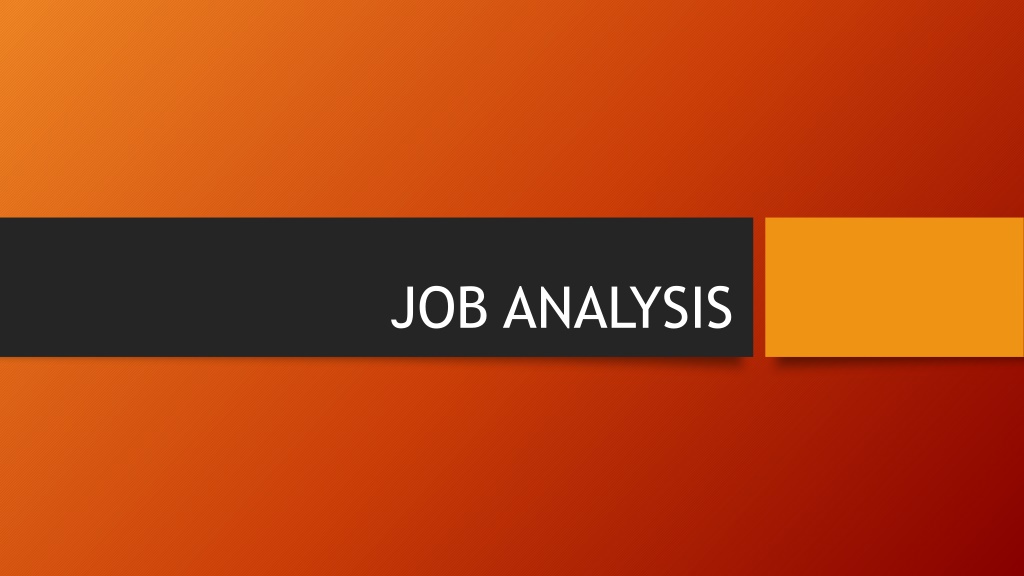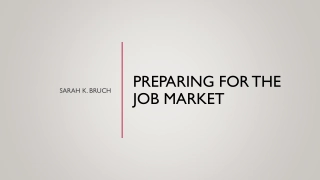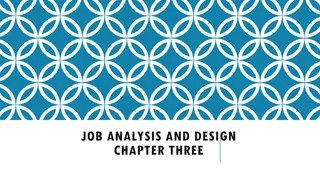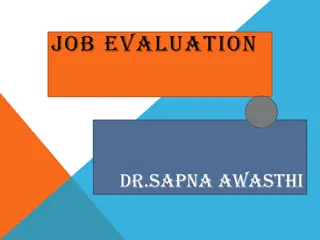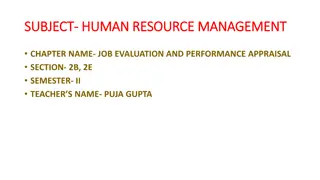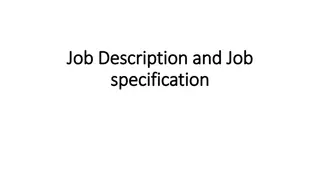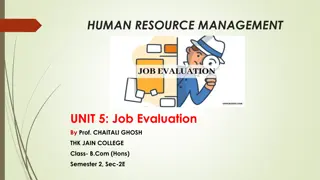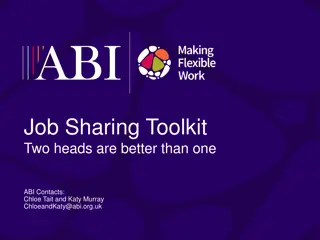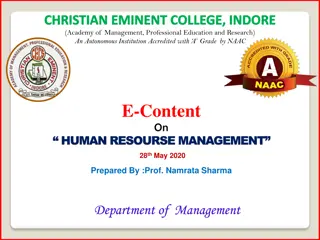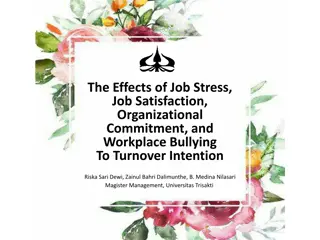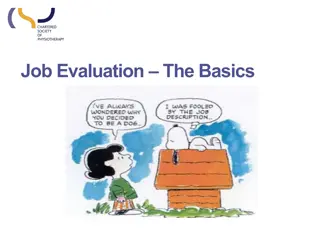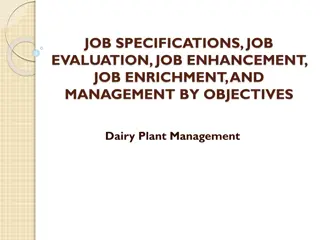Understanding Job Analysis Process and Components
Job analysis involves collecting information about a job, including the knowledge, skills, and abilities required for effective performance. It covers work activities, tools and equipment used, work performance standards, job context, and personal requirements. The process helps in defining job roles and responsibilities accurately to enhance organizational efficiency.
Download Presentation

Please find below an Image/Link to download the presentation.
The content on the website is provided AS IS for your information and personal use only. It may not be sold, licensed, or shared on other websites without obtaining consent from the author. Download presentation by click this link. If you encounter any issues during the download, it is possible that the publisher has removed the file from their server.
E N D
Presentation Transcript
JOB A job is a bundle of related tasks It transcends beyond related tasks and the money they carry. Job is a synonym of work Work has two broad categories The Physiological perspective looks at the individual behaviour which concerned with managerial problems of learning, attitudes, perception, motivation & job satisfaction The sociological dimension of work is concerned with the broader contextual and structural factors affecting people s experience of work
JOB ANALYSIS Job analysis is the process of collecting information about a job which involves knowledge, skills, ability (KSA) the incumbent should posses to discharge a job effectively Knowledge may be understood as the extent to which the job holder is familiar with his/her job Skills refers to the specific capability to operate a machine/system Ability refers to the physical and mental capacities needed to perform tasks not requiring the use of tools, equipment & machinery
Types of information to be collected by job analysis Work Activities work-activities/processes procedures used activity records personal accountability/responsibility Worker-Oriented Activities human behaviours performed in work elemental motions personal job demands
Machines, Tools, Equipment, and Work Aids Used computers(hardware/software) safety equipment's (goggles/gloves) office tools(phone, fax, books) Job-Related Tangibles and Intangibles materials processed products made knowledge dealt with or applied services rendered
Work Performance work measurements work standards error analysis other aspects Job Context physical work conditions work schedule organized context incentives
Personal Requirements job-related knowledge and/or skills ( education, training, work experience required) personnel attributes ( aptitudes, physical characteristics, personality, interests required)
Process of Job Analysis Strategic choices Gather Information Process information Job description Job Specification
Strategic choices The extent of employee involvement in job analysis The level of details of the analysis Timing and frequency of the analysis Past-oriented vs Future-oriented analysis Sources of job data
Gather information What type of data is to be collected? What methods are to be employed for data collection? Who should collect the data? Data collection methods are : observations, interviews, checklists, questionnaire, technical conferences, diary methods
Process information Once the information is collected, it should be processed so that it would be useful in various personnel functions
Job Analysis results in Job Description Job Specification
JOB DESCRIPTION It implies objective listing of the job-title, tasks, duties and responsibilities involved in a job
Job analysis contains a statement containing items as: Job title Location Job summary Duties Machines, tools and equipment's Materials and forms used Working conditions Hazards
Template of Job Description Page no: 132-134/ Aswathappa
Job Specification A job specification is a document which describes education, experience, skills, knowledge required to perform a job. It is a very important document used by HR professionals to communicate the desired people requirement in the organization It involves listing of employee qualifications, skills, knowledge and abilities
Job Specification contains Education Experience Training Judgement Initiative Physical effort Physical skills Responsibilities Communication skills Emotional characteristics
Job Design The methods used to develop the content of a job including the relevant tasks as well as the processes by which jobs are constructed and revised. The method which involves conscious efforts to organise tasks, duties and responsibilities into a unit of work to achieve certain objective.
Factors affecting Job Design Feedback Organizational Factors Environmental Factors Productive and satisfying job. Job Design Behavioral Factors
Organizational Factors Task Workflow Work practices Ergonomics ( It concerned with designing & shaping jobs to fit the physical abilities and characteristics of employees)
Behavioural Factors Feedback Autonomy Use of abilities Variety Job rotation
Environmental factors Employee Abilities and Availability Social and Cultural Expectations Hours of work, holidays, vacations, rest breaks, religious beliefs, management styles, worker attitudes .
Job Reengineering Heavily relied upon the scientific management approach and industrial engineering approach. The approach is concerned with product, process , tool design, plant layout, Standard operating procedures, work measurement and standards. Some of the visible practices are cybernation, Artificial Intelligence, (AI) and Computer assisted design (CAD)
Job Enrichment An outcome of the Herzberg s two factor theory of motivation. It Involves a greater variety of work content which require higher level of knowledge and skill, offers opportunity for autonomy and responsibility in terms of planning, directing and controlling their own perfomance and provide the opportunity for personal growth and a meaningful work experience. It speaks for a vertical loading of the job.
